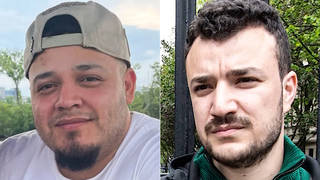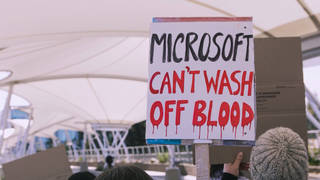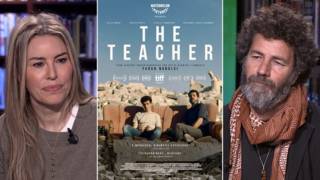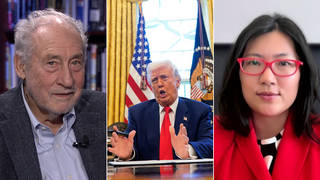
Topics
Guests
- Ananya RoyProfessor in the Department of City and Regional Planning at the University of California, Berkeley. She is the author of Poverty Capital: Microfinance and the Making of Development.
Protests were held on several California campuses last week as part of the National Day of Action to Defend Public Education and Social Services. California Governor Arnold Schwarzenegger also restored some $300 million of funding following months of statewide protests, rallies and walkouts over the drastic budget cuts. We speak to Ananya Roy, a University of California, Berkeley professor who was a part of the Solidarity Alliance at the height of the protests earlier this year. We also speak to Roy about her latest book, Poverty Capital: Microfinance and the Making of Development. [includes rush transcript]
Transcript
AMY GOODMAN: We’re on the road right now in San Francisco. We’ll also be here tomorrow. But right now we’re going to talk about the protests that were held on several California campuses last week as part of the National Day of Action to Defend Public Education and Social Services.
The University of California has faced major cuts and fee increases after the state legislature voted last year to cut the University of California and California State University systems’ 2009-2010 budget by $637 million. Last week, California Governor Arnold Schwarzenegger restored some $300 million of funding. The Governor’s decision to restore some funding follows months of statewide protests, rallies, walkouts over the drastic budget cuts.
Well, we’re joined right now by Ananya Roy, professor in the Department of City and Regional Planning at the University of California, Berkeley. She was a part of the Solidarity Alliance at the height of the protests earlier this year. Her latest book is called Poverty Capital: Microfinance and the Making of Development.
Welcome to Democracy Now!
ANANYA ROY: Thank you.
AMY GOODMAN: So, let’s start on where education stands today in California.
ANANYA ROY: Well, you’ve been talking about California all morning, and public education is a very important piece of that story. We’re now marking a year of action and advocacy to make visible the crisis of public education, but to also make visible that this is part of the larger crisis of priorities in California. Now, as you mentioned, the Governor and the legislature has indeed restored about $300 million to the UC and California State University system, but there is a great deal more work to be done, because in fact there is a deferring of funding payments to K-through-12 and to the community college system. And I think more importantly, California hasn’t dealt with the issue that we need to find new revenue streams in order to finance the infrastructure, be it roads and highways or public education, that can make California competitive and somewhat of a socially just and environmentally sustainable place in the future.
AMY GOODMAN: I’m wondering if you’ve seen Waiting for Superman, the documentary. It has gotten a tremendous amount of attention. And there are many people who are concerned that the whole push for charter schools, while they’re not private schools, is actually going to take money away from public education, the public schools, as we know them.
ANANYA ROY: I think that there are many possible solutions to the public education crisis in America. But I think valuing public education has to be a part of this. And I don’t think it’s good enough to say, for example, that the teachers unions remain a central problem, as we often hear in many narratives. We heard it again in the gubernatorial debates, the argument that really this is a problem of unionized public employees, that is the problem with the public pension plan, that is the problem with the school system, when really the problem is that we spend quite a bit, as a state and as a country, on a whole set of priorities within which public education falls rather low.
AMY GOODMAN: I want to turn to the discussion of microfinance, the subject of your latest book.
ANANYA ROY: Yes.
AMY GOODMAN: On Wednesday, the president of the United Nations General Assembly, Joseph Deiss, hailed microfinance as, quote, “a key instrument for improving the living conditions of poor populations.” Meanwhile, in southern India, microfinance institutions is now in the hot seat after reports that as many as thirty rural borrowers have committed suicide following their inability to pay back loans from microfinance institutions that were charging exorbitant interest rates. Professor Roy, your book is called Poverty Capital: Microfinance and the Making of Development. Can you explain what microfinance means and what is poverty capital?
ANANYA ROY: Microfinance is the practice of giving small loans, micro loans, to very poor people, mainly women, those who do not have the collateral that is recognized by the formal banking system. So microfinance, as it started, was an attempt to include the poor in financial systems. It was a solution to the redlining of the poor by financial institutions.
But I got interested in microfinance, because there’s a real battle that is going on for the soul of microfinance, which I think is also a battle for the soul of development. On one hand, you have models of microfinance that are highly commercialized, that are profit making, that are becoming the darlings of Wall Street with these massive IPOs, and really they borrow the norms and standards of the financial industry. One can think about them as representing the financialization of everything. And on the other hand, we have a set of microfinance institutions, many of which I’ve studied in places like Bangladesh, that are experimenting with social protection, that are some of world’s largest pro-poor, service-delivery institutions, and they don’t often make the headlines, though they should. So this battle between these two models of microfinance, I think, embodies a larger battle over anti-poverty interventions, but also around development itself.
AMY GOODMAN: What gives you hope? What are the movements that give you hope?
ANANYA ROY: Well, I did this book because I believe, on the one hand, that one has to be quite cautious and critical about the ways in which anti-poverty interventions are undertaken. The book is called Poverty Capital, because I study the ways in which there’s an effort to capitalize poverty, to turn it into a new frontier of capitalism. But I also believe that the future is open, that there are counter-movements and institutions that have been fighting to create social protection programs. And in Bangladesh, I’ve been very inspired by, say, the work of BRAC, which is perhaps the world’s largest pro-poor, service-delivery organization, that has a massive infrastructure of everything from primary schools to health clinics to the ability to provide savings and credit services for the poor.
AMY GOODMAN: How does BRAC compare to the Grameen Bank, which is so famous, Muhammad Yunus winning the Nobel Peace Prize?
ANANYA ROY: They belong to the same family of programs. And I think what’s interesting about the Grameen Bank and BRAC, that we often know them for microfinance, for the fact that they give small loans to the poor, my research shows that really the story is not about credit. It is about such things as asset building for the poor. It is the building of political power among the poor. And most importantly, and this is surprising, it’s about savings programs, that the poor may need access to savings much more than they need loans that put them in debt.
AMY GOODMAN: Professor Roy, you have made a comparison to some microfinancing to subprime loans. Explain how.
ANANYA ROY: Well, the book was being written while the subprime crisis here in America was unfolding, and I was struck by the parallel between what we were seeing in this world of poverty capital and the subprime crisis here in the American housing market. I think the idea of microfinance resembles subprime in that they both are responses to the redlining of certain social groups from financial institutions. The subprime mortgage or microfinance allows financial inclusion, but on terms that are segmented, on terms that are different than the interest rates enjoyed by prime borrowers. And the question for microfinance institutions today is whether or not they are going to slip into a mode of predatory lending, that when we have organizations that are charging 80 percent or 90 percent interest rates, is that in fact a financial innovation? Or is that predatory lending?
AMY GOODMAN: As you talk about these issues and we move from the Bush administration to the Obama administration, how has this new administration — not so new right now — influenced these issues?
ANANYA ROY: Well, the project of development, as it is managed in Washington, DC — or rather, by the Wall Street-World Bank-IMF complex — is dreadfully broken, that there isn’t enough money being allocated to overseas development assistance. The money that is being allocated is shaped by narrow American geopolitical, often military, interests. Much of the aid goes — in fact returns right back to American corporations and American consultants. The Millennium Development Goals most likely will not be met. So there is a great deal of work to be done, and it’s work that has to be done in Washington, DC.
But the project of development is also now much greater than Washington, DC. It’s been taken up by a whole set of nonprofits, NGOs, social movements, and most importantly perhaps, by a generation known as the Millennials, the young men and women who are in classrooms like mine at places like Berkeley, who really believe that they can make a difference and that they can change the ways in which development aid is allocated or development knowledge is produced.
AMY GOODMAN: Back in the United States, since I think a lot of people now are asking — you know, you look abroad, but you can also look right here at home, when you look at increased poverty and other issues. For example, payday loans, a kind of microfinancing. How do you talk about that, this need for small loans in the country and the predatory nature of them?
ANANYA ROY: I think payday loans are a wonderful example of the need to be cautious and critical about these forms of financial inclusion. And, of course, in the US context, we have seen not only increasing poverty rates, but also increasing inequality rates. Payday loans remind us of the need to invent institutions that are truly pro-poor, to think about how services, including financial services, can be delivered to the poor in a way that is not predatory. And there is a great opportunity to do that.
AMY GOODMAN: Well, I want to thank you very much for being with us.
ANANYA ROY: Thank you.
AMY GOODMAN: Professor Ananya Roy teaches in the Department of City and Regional Planning at University of California, Berkeley. She is author of Poverty Capital: Microfinance and the Making of Development.












Media Options